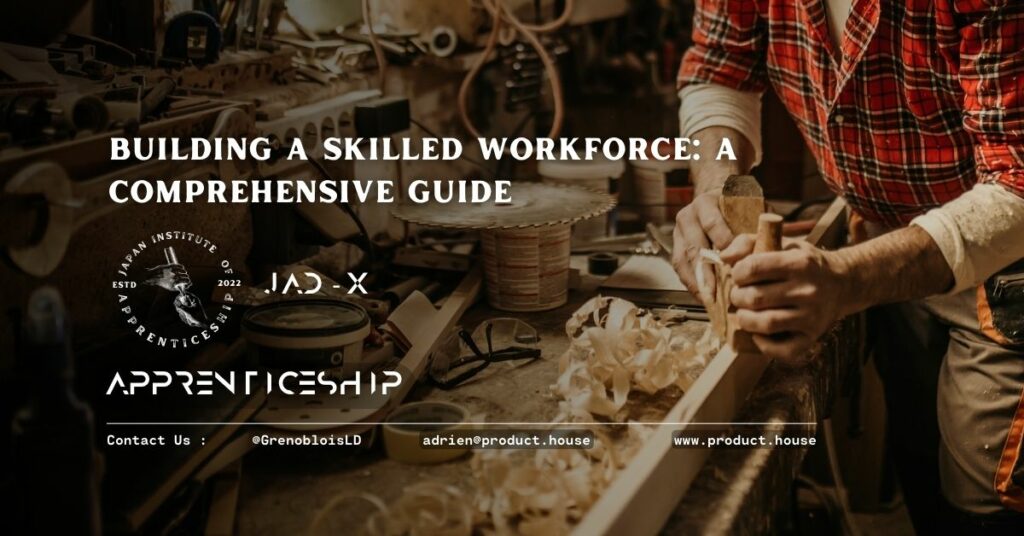Building a Skilled Workforce: A Comprehensive Guide to Apprenticeship Programs from Pre-Apprenticeships to ROI -Cluster

Apprenticeships have long been a staple of workforce development and training programs. An apprenticeship is a formal program that combines on-the-job training with classroom instruction, designed to prepare individuals for a specific trade or occupation. Apprenticeships have evolved significantly over time, and today they are available in a wide range of industries and professions.
This comprehensive guide to apprenticeships covers a range of topics, from understanding the basics of apprenticeships to exploring the latest trends and future predictions for these programs. The guide is divided into ten sections, each of which covers a specific aspect of apprenticeships in depth.
Introduction to Apprenticeships
The first section provides an introduction to apprenticeships, including an overview of what they are, a brief history of their evolution, and the top benefits they offer to both employers and employees. The section also explores the different types of apprenticeships that are available and how to choose the right program for your needs.
Pre-Apprenticeship
The second section focuses on pre-apprenticeships, which are training programs designed to prepare individuals for formal apprenticeships. The section explains the benefits of pre-apprenticeships, examples of best practices and successful programs, and how to choose the best program for your needs.
Apprenticeship Programs
The third section explores formal apprenticeship programs in depth, including how to get started with a program, the different types of program models, and what makes a successful program. The section also covers on-the-job training, which is a key component of most apprenticeships, and provides guidance on how to develop effective on-the-job training programs.
On-The-Job and Off-The-Job Training
The fourth and fifth sections focus on off-the-job training and financial aid for apprenticeships. These sections explain the benefits of each, best practices, and success stories. They also provide guidance on how to develop effective off-the-job training programs and how to apply for financial aid.
Structuring an Apprenticeship Program
The sixth section provides guidance on structuring an apprenticeship program, including key elements and how to design a successful program. The section also covers common mistakes to avoid when structuring an apprenticeship program.
Apprenticeship in Specific Industries
The seventh section explores apprenticeships in specific industries, including manufacturing, technology, healthcare, construction, renewable energy, culinary arts, and more. Each industry is covered in-depth, with information on how to build a successful apprenticeship program and examples of best practices.
Trends and The Future of Apprenticeship
The eighth section explores trends and the future of apprenticeships, including how digital transformation is impacting these programs, the skills gap, and how to address equity and diversity gaps. This section also covers the importance of soft skills, mentoring, and workplace culture in apprenticeships.
Other Topics Related to Apprenticeship
The ninth section covers other topics related to apprenticeships, including finding and retaining the best apprentices, fostering innovation and creativity, and the importance of inclusion and diversity.
Making an Impact
Finally, the tenth section covers the role of apprenticeships in corporate social responsibility, making a positive impact, and the importance of emotional intelligence in apprenticeships. The section also explores how to address talent shortages in various industries, including hospitality, healthcare, and legal.
In summary, this guide to apprenticeships covers a wide range of topics and offers comprehensive guidance on how to design, implement, and benefit from these programs. Whether you are an employer or an individual looking to enter a trade or occupation, this guide will provide the information and resources you need to succeed.
15 Books to Get Inspiration From
English:
- “The Apprenticeship Pathway: Preparing Students for Life and Work” by J. Scott & L. Pappas (2017)
- “The Complete Guide to Apprenticeship” by Samantha Grice (2020)
- “Building a Skilled Workforce: Apprenticeship and Training Programs” by A. G. Kleiner (2017)
- “The Apprenticeship Revolution: An Insider’s Guide to the Future of Work” by Adi Gaskell (2018)
- “Apprenticeship Patterns: Guidance for the Aspiring Software Craftsman” by Dave Hoover & Adewale Oshineye (2009)
- “How to Succeed in an Apprenticeship: Tips and Advice for a Successful Journey” by Michele R. Pitts (2020)
- “The Modern Apprenticeship: Building a Successful Career in the 21st Century” by Robert Newry (2018)
- “Apprenticeships for the New Millennium: Lessons from the German Model” by Lars Jorgensen (2007)
- “The Apprentice: My Life in the Kitchen” by Jacques Pépin (2004)
- “Apprenticeship in Critical Ethnographic Practice” by Jean Lave & Etienne Wenger (1991)
- “The Power of Apprenticeship: How to Learn Any Skill You Want” by Tony Sandhu (2020)
- “The Apprenticeship of Duddy Kravitz” by Mordecai Richler (1959)
- “Training the Industrial Worker: The American Apprenticeship System” by Paul H. Douglas (1937)
- “The Apprenticeship of Lucas Whitaker” by Cynthia DeFelice (1996)
- “The Great Apprenticeship: Learning the Art of Leadership” by Richard S. Deems (2012)
five books on apprenticeship in each of the requested languages:
Japanese:
- “若者の就職を変える――自己変革から始まる企業との『結婚』” by 小野田寛郎
- “職業教育史―ドイツ・イギリス・日本―” by 小林彰夫
- “仕事が教えてくれること―仕事に向き合う姿勢を育む魔法のレッスン” by チャールズ・フィッシュマン
- “明日から生き残る職人の心得” by 株式会社 伊藤忠商事
- “師匠の言葉: 今日から使える仕事の教科書” by 桐原書店
French:
- “L’art de l’apprentissage: Les méthodes d’apprentissage pour tout le monde” by Julien Geffroy
- “L’art de l’apprentissage: Étudier et apprendre avec plaisir” by Stanislas Dehaene
- “L’apprentissage des compétences pour le XXIe siècle” by OECD
- “L’apprentissage en entreprise” by François Meunier
- “L’apprentissage tout au long de la vie: Une approche globale” by Commission européenne
German:
- “Azubi-Recruiting: Wie Sie die besten Nachwuchskräfte finden und halten” by Bettina Rollow
- “Erfolgreich durchs Berufsleben: Strategien zur Karriereentwicklung” by Frank Bönker
- “Führungsverantwortung in der dualen Ausbildung” by Joachim Fiebelkorn
- “Ausbildung erfolgreich gestalten: Ein Leitfaden für Ausbildende und Ausbildungsverantwortliche” by Markus Hagemann
- “Ausbildungspraxis: Grundlagen – Methoden – Hilfsmittel” by Wilfried Kotthoff
UK:
- “The Apprenticeship Guide: How to Get an Apprenticeship and Make it Work for You” by Susan Gingell
- “The Apprenticeship Handbook” by Jason Holt
- “The Good Apprenticeship Guide” by Tom Bulman
- “The Ultimate Guide to Apprenticeships: Everything You Need to Know” by Stephen Lawrence
- “The Advanced Apprenticeship Guide: How to Get Ahead and Make the Most of Your Apprenticeship” by Jason Holt
FAQ
Q: What is an apprenticeship?
A: An apprenticeship is a formal program that combines on-the-job training with classroom instruction, designed to prepare individuals for a specific trade or occupation.
Q: What are the benefits of apprenticeships?
A: Apprenticeships offer many benefits to both employers and employees. For employers, they provide a way to develop a skilled workforce and reduce recruitment costs. For employees, they provide a path to a meaningful and rewarding career with the potential for higher earnings and career advancement.
Q: What types of apprenticeships are available?
A: There are many types of apprenticeships available, ranging from traditional trades such as carpentry and welding to newer industries such as technology and healthcare.
Q: How do I choose the right apprenticeship program?
A: Choosing the right apprenticeship program depends on your interests, skills, and career goals. It’s important to research different programs, speak with current and former apprentices, and consider factors such as program length, pay, and job prospects.
Q: What is the difference between on-the-job training and off-the-job training in apprenticeships?
A: On-the-job training takes place in the workplace, where apprentices work alongside experienced professionals to learn the skills of their trade. Off-the-job training takes place in a classroom or training center, where apprentices learn the theory and knowledge behind their trade.
Q: How do I apply for financial aid for an apprenticeship?
A: Financial aid for apprenticeships may be available through federal or state programs, as well as through private organizations. To apply, you’ll typically need to fill out a FAFSA or other financial aid application and provide information about your income and expenses.
Q: How do I structure an apprenticeship program?
A: Structuring an apprenticeship program involves a number of key elements, such as identifying the skills and knowledge that apprentices will need to learn, defining the roles and responsibilities of employers and apprentices, and designing a training curriculum that incorporates both on-the-job and off-the-job training. It’s important to consider factors such as program length, pay, and benefits, as well as compliance with any regulations or requirements.
Q: How do I measure the ROI of an apprenticeship program?
A: Measuring the ROI of an apprenticeship program involves tracking a number of metrics, such as the number of apprentices who complete the program, the time and resources invested, and the resulting benefits to both the employer and the apprentice. It’s also important to consider factors such as employee retention, productivity, and overall business performance.
Q: What is the future of apprenticeships?
A: The future of apprenticeships is likely to be shaped by a number of factors, such as advances in technology, changes in workforce demographics, and the ongoing skills gap in many industries. However, apprenticeships are expected to continue to play a key role in developing a skilled workforce and providing individuals with meaningful and rewarding career paths.
Q: How can I address equity and diversity gaps in apprenticeships?
A: To address equity and diversity gaps in apprenticeships, it’s important to create inclusive and accessible programs that are open to a wide range of individuals. This may involve partnering with community organizations, providing mentorship and support to underrepresented groups, and offering outreach and recruitment efforts that target diverse populations.
Reminders
- When choosing an apprenticeship program, it’s important to consider your interests, skills, and career goals.
- Structuring an effective apprenticeship program involves identifying key skills and knowledge, defining roles and responsibilities, and designing a comprehensive training curriculum.
- Measuring the ROI of an apprenticeship program requires tracking key metrics and considering the resulting benefits to both the employer and the apprentice.
- Addressing equity and diversity gaps in apprenticeships requires creating inclusive and accessible programs and offering outreach and support to underrepresented groups.





